FENNIMORE - About 50 interested citizens and half a dozen community advocacy groups gathered at Southwest Technical College on Saturday, Feb. 22, to hear two farmers discuss their approach to soil health and diversity. The event was hosted by Grant County Rural Stewardship.
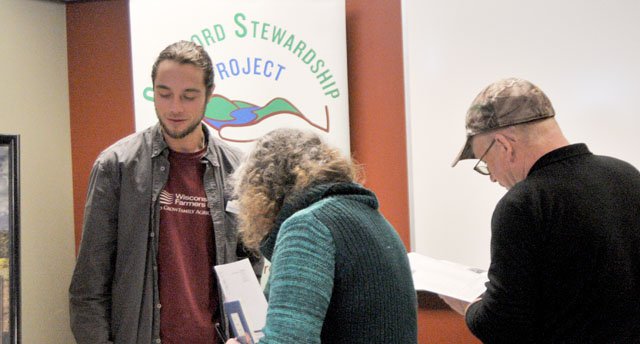
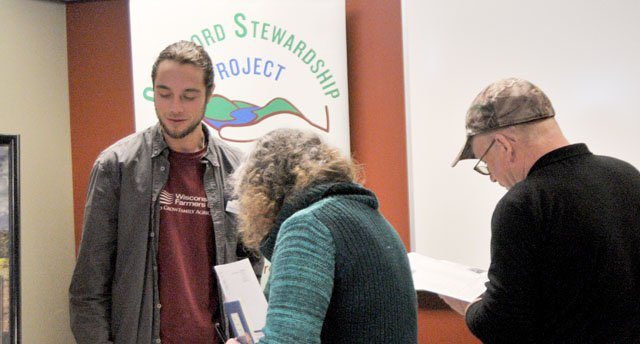
Mike Miles has been a Catholic Worker for 45 years, and most of that time has been spent on Anathoth Farm in rural Luck, Wisconsin, in Polk County. For 12 years, he has been practicing regenerative agriculture as one of the best solutions to climate chaos. On his farm, the crew raises pastured beef, pork, chicken and eggs–using managed intensive grazing.
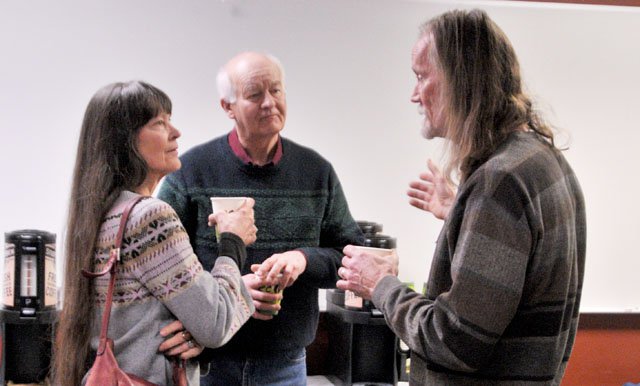

Miles is currently on the board of directors of the Northwest Wisconsin Graziers Network, and treasurer of the Polk/Burnett chapter of the Wisconsin Farmers Union.
Scott Mericka and his family run Grass Dairy LLC in rural Dodgeville. The business includes the farming operation and Uplands Cheese Company. The Merickas operate in partnership with Andy Hatch and his family, with Hatch being in charge of the cheese operation. The farm milks 200 cows and grows a variety of crops, with the most important crop being diverse perennial pasture. Grass Dairy markets most of their milk through the on-farm cheese plant, and the balance through Rolling Hills Dairy Producers Cooperative. Uplands Cheese is sold across the country and in some export markets.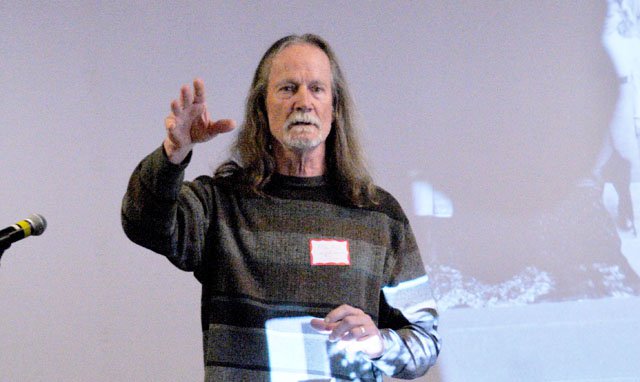
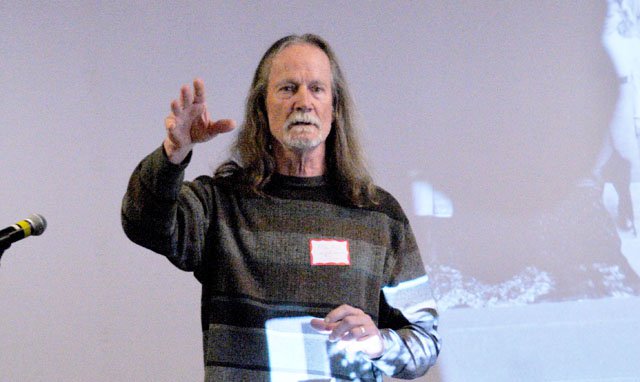
Back to the land
Mike Miles got his inspiration for agriculture on the 240-acre farm his great grandparents bought outside of Grand Rapids, Michigan, after they immigrated from Prussia.
“I loved being on that farm with my 12 cousins,” Miles remembered. “And the only thing I ever wanted to be was a farmer.”
In addition to his grandmother, Miles had a few mentors he mentioned in his presentation. One of those mentors was Phillip Berrigan, an American peace activist and Roman Catholic priest. Miles had met him while living in Baltimore in the early 1980s. They were also influenced by Catholic Worker Dorothy Day.
“Father Berrigan put a passion under me and my wife to embrace the world with everything we have,” Miles said. “It was Father Berrigan who introduced me to the French agrarian model of farmer communes.”
Miles and his wife returned to the Midwest and purchased an 80-acre farm with his brother in Polk County – Anathoth Farm.
“For the first 20 years on the farm, we had a big garden and made maple syrup, but we weren’t really farming,” Miles said. “Instead, we were putting our energy into opposing nuclear war and fighting the Navy’s Project Elf in northern Wisconsin and the Upper Peninsula of Michigan.”
As the years went by, however, Miles was exposed to such writers, thinkers and doers as Michael Pollan and the ‘Omnivores Dilemma;’ Joel Salatin, Alan Savory, and especially North Dakota farmer Gabe Brown. He also recommends ‘The Soil Owners Manual’ by John Stika.
“We decided that for the health of the planet, we needed to introduce animals into our farm system,” Miles remembered. “The first animals we got were pigs, followed by chickens for eggs, broilers and eventually beef steers.”
Ruminants extolled
Miles extolled the virtues of ruminant mammals, pointing out that of the 5,000 species of mammals only about 200 of them are ruminants. His focus on ruminants, which he describes as the “powerhouses” of everything they do on the farm, is because of their ability to convert forages into protein and enhance soil health with their manure.
“The most important thing that any farmer grows on their farm is the soil microbiology,” Miles emphasized. “And the mycorrhizal fungi in the soil are the ‘interstate’ and ‘internet’ of soil health.”
Miles described the way in which the mycorrhizal fungi in the soil form a network connecting all the plants in the soil through their roots. He said they function as the ‘internet’ of the soil, helping plants to source the nutrients they need, and the ‘interstate’ of the soil, helping to transport those nutrients to the plant.
Miles pointed out that back when he took his degree in zoology at the University of Iowa, there were only considered to be two kingdoms–plants and animals.
“Now zoology students learn that there are seven kingdoms, and they each represent some fraction of the total carbon on the Planet Earth,” Miles said. “Plants are the biggest kingdom, representing 450 gigatons of carbon; bacteria represent 70 gigatons; whereas humans represent only 0.06 gigatons.”
Soil organic matter
Miles discussed the need to increase soil organic matter in order to increase the fertility of the soil, and in these times of ever-increasing rainfall events, to store more water in the soil.
“Every one percent increase in soil organic matter means that cropland can store the amount of water that flows over Niagara Falls in 150 days,” Miles said. “My favorite example is North Dakota farmer Gabe Brown who took the soil organic matter on his farm from around two percent when he bought it to between 8 to 11 percent through regenerative agricultural practices.”
Miles said that when Brown had first purchased his farm, his soils could store a half-inch of rain per hour. Now, Miles said, Brown’s soils can store eight inches of rain per hour, an advantage in North Dakota where drought can be a threat.
In addition to Gabe Brown, Miles’ approach to agriculture and land management has been influenced by rural LaFarge farmer Mark Shepherd. Shepherd taught Miles to use swales and key lines to store water and capture nutrients on his land. In addition, Miles had adopted the over-wintering practice for his cattle of bale grazing. This practice returns carbon to the land it was taken off of, and distributes the cattle’s manure over the landscape, eliminating the need for manure storage.
Miles had also been influenced by the work of the Savanna Institute.
“On our land, we’re either working to introduce woody vegetation into our pastures or thin the trees in our woods to achieve a 60 percent canopy,” Miles explained. “This allows for more diversity on our landscape, more food for our animals, and needed shade as well.”
Miles ended his talk by recommending that people read the book ‘Drawdown,’ edited by Paul Hawken, which discusses what it will take to reverse climate change. Regenerative agricultural production is listed as the 11thmost impactful of 80 different climate change solutions.
“I always encourage people to think in terms of regenerative agriculture,” Miles said. “Most of our agricultural land is so degraded, that we will have to engage in regeneration before we can truly practice sustainable agriculture.”
Anathoth Community Farm is a Catholic Worker farm based on the study and practice of nonviolence, community, and sustainable living. Products marketed by the farm include grass-fed beef and chicken, and maple syrup. You can connect with them on Facebook, or at 715-472-8721.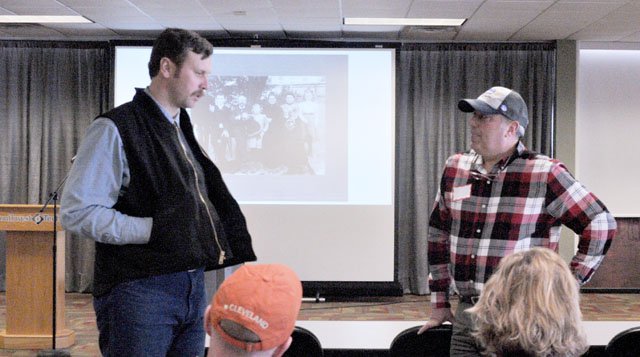
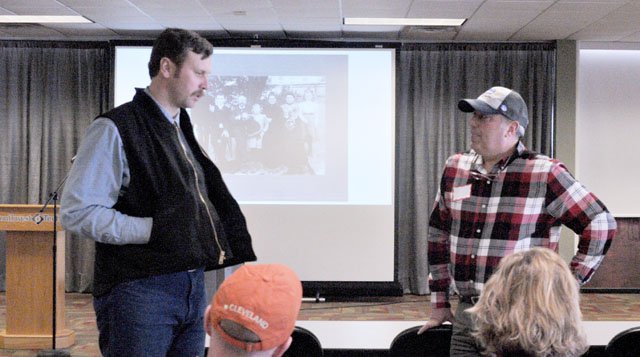
Farmstead cheese
Scott Mericka told the workshop participants his story of how as a 28-year-old with a family, he had decided to get into dairy farming and make a sustainable living.
“Ag is my life, even though I’m a first generation dairyman,” Mericka said. “The way that I have been able to be successful as a dairy farmer is through the practice of holistic grazing.”
Mericka talked about how his first experience in agriculture had been in managing a dairy CAFO in California. That experience had led him to “look for a better way.”
His strategy is to manage his land for maximum production, and to work with a guaranteed market for his milk through the on-farm cheese business, Uplands Cheese Company.
The cheese company is managed by his friend Andy Hatch. They produce two cheeses at their farmstead dairy – Pleasant Ridge Reserve, an ‘alpine-style’ cheese, and a holiday specialty cheese, Rush Creek Reserve.
Mericka said that a lot of his success comes from selecting ‘athletic breeds of cows’ that can get out in the pasture and go after their food, and tolerate the weather.
The dairy is a seasonal grazing operation, producing milk in the spring, summer and fall. In his operation, the cows calve in March and April, feed off of live forage in the growing season, and are all dried off at the same time in the fall. They ‘group raise’ their calves with a ‘mob nursing’ system, which results in healthy calves, acclimated to being outside, and well socialized.
“We call our system ‘summer love,’ where the cows are all bred in the summer,” Mericka said. “Timing of reproduction is crucial for seasonal dairy.”
In the fall, Mericka says, they will back off from two milkings per day to one. Ultimately, he is seeking a system that will allow him to do a one-milking-per-day system throughout the season. They dry their cows off in January, and then go to a bale grazing and silage feeding system in the winter.
Like Miles who spoke before him, Mericka emphasized that the basis for his farming success lies in soil health. Managed grazing is the best practice, he says, to weather the increasingly large rainfalls we are seeing, and also provides a diverse farm system that is habitat for pollinators.
Dog and a dirt bike
“Basically, cows are my farm implements,” Mericka said. “I always say, if you can’t do it with a dirt bike and a dog, then why bother.”
Mericka says that during the growing season, they move their cows often – sometimes two times per day. They also do some first crop hay, and are working with the ‘stockpile grazing’ method, allowing the cows to eat standing corn, forage kale, and other forages during the winter. He says he tries to get through as much of the season as possible relying only on grazing to feed the cows. As a result, because the cows are out on pasture, he reports that he only has to handle about 15 percent of the manure generated by his operation.
The equipment that Mericka says a managed grazier needs is wire fence for paddocks, a watering system, lanes which keep the cows cleaner moving between paddocks and the barn, a dog, and a dirt bike.
During the growing season, Mericka says he and his crew walk through every pasture weekly. While doing so, they calculate the dry matter available in the paddock, and what their rotation will be.
He uses a Kline irrigation system in his paddocks to provide ‘drought insurance,’ though he says that there has been nothing but rainy years since he installed it. But he says, with climate change, sooner or later there’s going to be a drought, and then they’ll be ready for it.
“If there is a surplus of forage, then we cut hay,” Mericka said. “If there is a deficit, then we extend the rotation or feed the cows a little more grain.”
Mericka said that the intense rainfalls resulting from climate change have posed increasing problems for him on his farm. He said he has experienced more rain, and more mud, and emphasized the value of investing in good lanes for the cows in order to keep them clean.
Crop rotation
Mericka described a typical crop rotation used in his fields. He said it starts in the winter when they outwinter their cows. That is followed by limited tillage in the spring and a planting of forage sorghum. Sorghum is “grazeable within 55 days.” He said that he will rotate the cows on and off the sorghum, alternating with grass and this helps his pastures last longer.
In the fall, he will follow up the sorghum with a planting of winter rye, which will be grazed in the spring. After that, the field will be lightly tilled and planted into a diverse pasture mix that includes grasses and clover. He emphasized that for good pasture, diversity is the key.
Future of agriculture
Starting with a slogan of ‘Farm on Wisconsin!,’ Mericka said that the state is going to have to make some tough decisions about the future of its agricultural economy.
Do we want to settle for the corporate domination of our food supply?
Do we want clean or polluted water?
Do we want stronger communities with a greater diversity of businesses?
Do we want more or less families in our rural communities?
Do we want agriculture to be a cause of or a solution to climate change?
He points to the model employed on his farm as a method that could allow other farmers to be successful.
“We are price setters, not price takers,” he said. “The artisan cheese market is expanding rapidly.”
He said that he thinks a big part of the future for farmers is to get paid for conservation. Conservation can be an income stream for farmers, in the form of carbon or water credits, and this will help both our farm economy and our planet.




